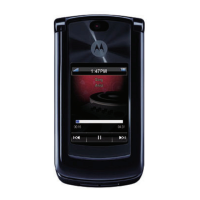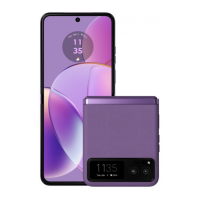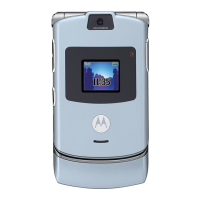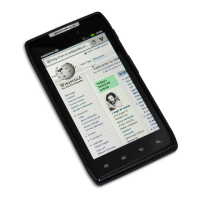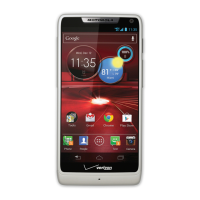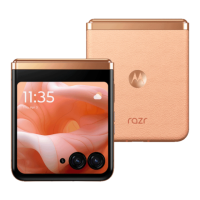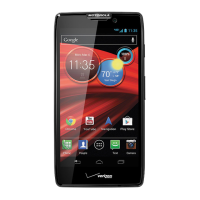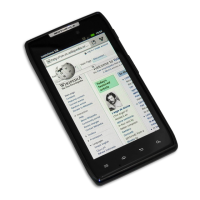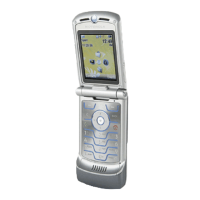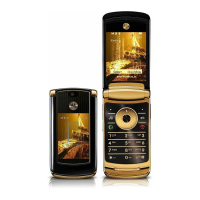
Do you have a question about the Motorola RAZR2 V8 and is the answer not in the manual?
| Network Technology | GSM / HSPA |
|---|---|
| 2G bands | GSM 850 / 900 / 1800 / 1900 |
| GPRS | Class 10 |
| EDGE | Class 10 |
| Status | Discontinued |
| Dimensions | 103 x 53 x 11.9 mm (4.06 x 2.09 x 0.47 in) |
| Weight | 117 g (4.13 oz) |
| SIM | Mini-SIM |
| Type | TFT, 256K colors |
| Pixel density | 182 ppi |
| Memory Card slot | No |
| Call records | Yes |
| RAM | 512 MB |
| Primary Camera | 2 MP |
| Video | Yes |
| Alert types | Vibration; Downloadable polyphonic, MP3 ringtones |
| Loudspeaker | Yes |
| 3.5mm jack | No |
| WLAN | No |
| Bluetooth | 2.0, A2DP |
| GPS | No |
| Radio | No |
| Browser | WAP 2.0/xHTML, HTML |
| Games | Yes + downloadable |
| Java | Yes, MIDP 2.0 |
| Colors | Black, Silver |
| Announced | 2007 |
| Size | 2.2 inches |
| Resolution | 240 x 320 pixels |
| Second external display | TFT, 256K colors, 240 x 320 pixels |
| Available Memory | 420 MB |
| USB | v2.0 |
| Messaging | SMS, MMS, Email |
| Operating System | Linux |
| Battery | Removable Li-Ion battery |
Displays when the phone is turned on.
Access to phone features and applications.
Features for making and managing calls.
Managing phone contacts and addresses.
Tracking call duration and expenses.
Using the phone hands-free.
Managing network connections and settings.
Tools for scheduling and organization.
Instructions to avoid damage from water, rain, dust, and dirt.
Initial setup and basic phone operations.
Guidelines for charging and safe use of the battery.
Overview of the phone's display and home screen.
Icons showing phone status on the home screen.
Explains location and alert profile status icons.
Methods and options for entering text on the phone.
How to enter numbers using the keypad.
Adjusting earpiece, speakerphone, and alert volumes.
Using the navigation key for menu interaction.
Information shown on the phone's closed display.
Dialing numbers using voice commands.
Using voice to operate phone features.
Phone reads out caller ID, menu items, and messages.
Setting keys to lock automatically when idle.
Locking the phone manually using the unlock code.
Customizing alert styles for different situations.
Managing saved phone profiles.
Synchronizing and setting phone time and date.
Adjusting brightness, wallpaper, and screen saver.
Customizing the order of menu items.
Customizing menu folders with icons.
Configuring how to answer incoming calls.
Silencing the ringer before answering a call.
Redialing missed or busy calls.
Making emergency calls.
Accessing and listening to voicemail messages.
Surfing the web using the phone's browser.
Using the browser to search the web.
Accessing web-based email accounts.
Capturing images with the phone's camera.
Discarding, sending, or saving photos.
Customizing camera capture options.
Capturing video clips with the phone.
Setting options for video capture.
Uploading videos to a blogging service.
Options for playing videos, including fullscreen.
Sending and receiving text messages.
Sending pre-written text messages.
Composing and sending emails.
Sending messages with pre-installed media.
Accessing previously received emails.
Viewing messages received through the browser.
Setting up and managing instant messaging accounts.
Setting up synchronization with ActiveSync.
Synchronizing data manually with a server.
Accessing and managing files on the phone.
Copying files using a USB cable.
Copying files between phone and computer.
Printing photos via USB PictBridge.
Managing the Bluetooth radio's power state.
Connecting to Bluetooth audio devices.
Transferring files to other Bluetooth devices.
Accepting file transfers from other devices.
Printing photos to Bluetooth-compatible printers.
Selecting a printer and managing print jobs.
Dropping or removing Bluetooth devices from the list.
Modifying settings for paired Bluetooth devices.
Configuring general Bluetooth settings.
Information on making calls to other countries.
Notifying about incoming calls during an active call.
Setting up and managing multi-party calls.
Moving an active call to another number.
Using the phone with TTY devices.
Restricting calls to numbers in a fixed list.
Setting up speed dial numbers.
Customizing how contacts are displayed.
Entering new contact information.
Sending messages directly from contact entries.
Assigning photos to contacts for caller ID.
Assigning custom ringers or alerts to contacts.
Organizing and filtering contacts by category.
Making lists for group messages or emails.
Transferring contacts from phone memory to SIM.
Sharing contact information via Bluetooth or message.
Importing contact information from vCard files.
Changing the phone's menu and display language.
Showing or hiding the date on the home screen.
Restoring phone settings to defaults.
Erasing personal information and downloaded content.
Erasing data stored on the SIM card.
Setting credit limits for calls.
Notes on safe handsfree phone use while driving.
Enabling voice dialing using headset controls.
Installing phone software updates from the service provider.
Dismissing or snoozing active alarms.
Viewing and editing calendar entries.
Organizing files downloaded from browser or Bluetooth.
Writing and storing text notes on the phone.
Capturing and saving audio notes.
Listening to recorded voice notes.
Managing the SIM card's Personal Identification Number.
Enabling/disabling internet access certificates.
Disabling network features for flight safety.
Information on obtaining assistance and support.
Details on meeting government requirements for radio wave exposure.
Product compliance with EU directives.
How to obtain source code for included software.

